Industry, UC San Diego Find New Opportunities in Qualcomm Institute Innovation Space
San Diego, May 14, 2015 — Representatives from the first seven companies admitted into the Qualcomm Institute Innovation Space wowed the campus community at a press briefing and networking reception to mark the official opening of the new 6,000-square-foot facility inside Atkinson Hall on the UC San Diego campus. The event took place on Thursday, May 7.
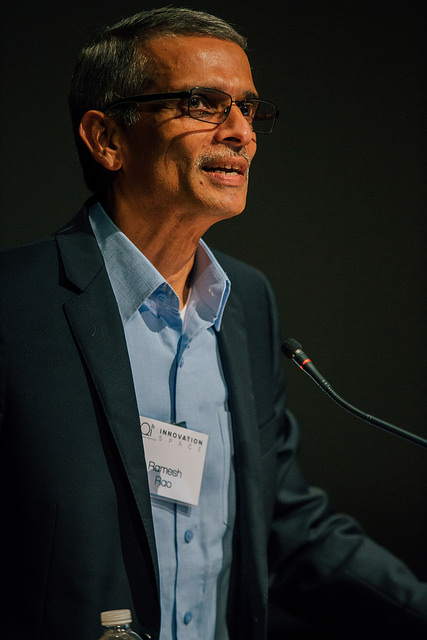
Qualcomm Institute director Ramesh Rao noted that it took more than two years to carve out a place where industry partners and faculty startups could lease space inside QI’s building. It required approvals from various campus units as well as a refinancing of 60 percent of the bonds originally floated to finance construction of the building. At launch, office or lab space in the new QIIS facility costs industry tenants $3 per square foot in rent, all of which goes to the campus. Tenants – who must be approved by a faculty committee – also gain the ability to use recharge services and facilities such as the Nano3 cleanrooms and various wireless, photonics and prototyping labs.
“We are not an incubator, although at times we expect to collaborate with incubators such as EvoNexus and JLABS,” said Rao, who sees the Innovation Space as a kind of pre-incubator. “As engineers, we tend to think of inputs and outputs, so we see QIIS as a place where industry and university can get together and create the fertilized egg that will go on to require incubation. We aspire to produce incredibly credible eggs.”
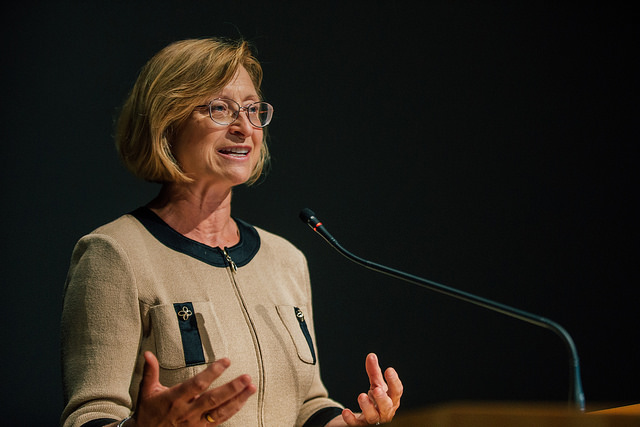
UC San Diego Vice Chancellor for Research Sandra Brown welcomed the new facility. “The initial partners are either startups from UC San Diego, or they are affiliated with ideas and designs that came out of UC San Diego, and we’re so proud of that,” explained Brown. “I’m not surprised that we start this here at the Qualcomm Institute, which has been the hub of so much innovation here at UC San Diego.”
“The goal is to take scientific ideas out to products and services and licenses and startups in a much more rapid way than ever before,” Brown added. “We want to further our DNA of innovation.”
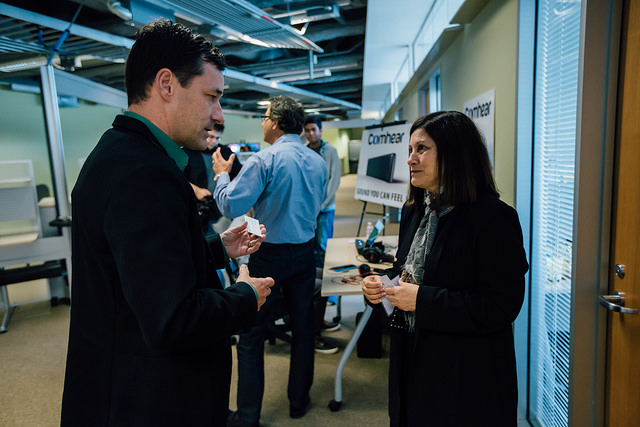
Comhear, Inc., was the first company admitted to the Innovation Space, when it was still in the planning stage. “It has been one year since we started working with Peter Otto in the institute’s Sonic Arts R&D group,” recalled CEO Randy Granovetter, admitting that it was a challenge. “I’m on a schedule, they’re on research [time]. But we could not have done it without Peter’s group, without the cooperation, without the engineering expertise.” Granovetter announced that the first product for the consumer market, MyBeam, will be shipped globally in the fourth quarter of 2015. The company will also begin selling its spatial audio conferencing solution for the enterprise market. While Comhear originally planned to remain headquartered in QIIS for its first two years, the company is growing so fast that it had to look for a permanent office off-campus, while continuing to lease office space for one or two people in QIIS who will continue to collaborate most closely with the Sonic Arts team and QI’s Audio Spatialization Laboratory.

UC San Diego alumnus Jamie Alexandre (PhD, Cognitive Science ’14) is a co-founder of the non-profit Foundation for Learning Equality (FLE). Run completely by current and former students, FLE is targeting a huge market: 357 million children in the world unable to attend school, and another 250 million who are not learning enough despite attending school because of overcrowded classrooms, unequal access to education, etc. “It’s a vicious cycle between lack of education and poverty,” said Alexandre. There is a lot of potential in online education, he says, “but almost two-thirds of the world does not have access to the Internet. Even worse, the poorest communities have the least access. The poorest countries have only 7.1% Internet penetration. So we asked ourselves, how can we bridge the gap between the abundance of fantastic learning resources online and the urgent need for better educational opportunities around the world?” FLE came up with the idea of packaging all of Khan Academy’s 7,000-plus educational videos and 1,600-plus interactive exercises on a huge array of topics into an offline platform they call KA-Lite. Alexandre pointed to a map of the world with locations (see map) where institutions in more than 150 countries have downloaded the open-source KA Lite software to engage with Khan Academy content locally. “This is a map of places where it has been installed, usually by the local community,” he said. “All the content can be loaded on a local server without needing upstream connectivity.” Classrooms were the initial target, but users now include community centers, prisons, refugee camps, after-school programs and other venues. But “we don’t want to stop there,” said Alexandre. “Our next step is a tool for empowering users to create and share their own lessons.” He announced during the press briefing that FLE has a platform in the works called Kolibri for the creation and sharing of open educational content to meet local cultural, linguistic and curricular needs of communities, then allowing content to be seamlessly passed along from person to person, device to device, for viewing on low-cost hardware, and shared back up to a central repository when Internet is available.
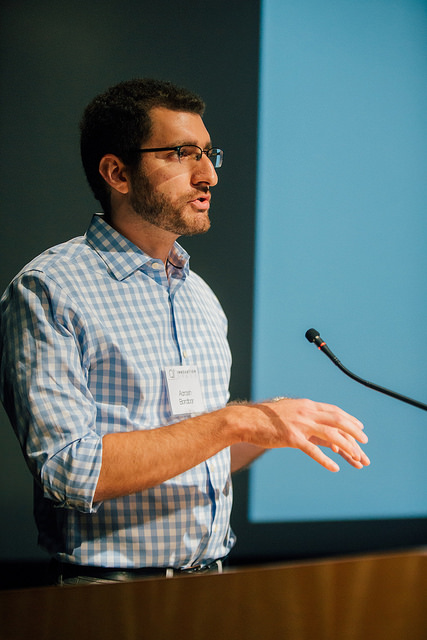
Another startup, Sinopia Biosciences, is also tackling a huge problem. “Our main focus is on an inconvenient truth for pharmaceutical companies,” said alumnus Aarash Bordbar (BS ‘08, PhD ‘14), who co-founded the company with UC San Diego Bioengineering professor Bernhard Palsson. “Adverse drug reactions are an enormous health and financial burden and the numbers are staggering: 100,000 deaths per year in the U.S. related to drug side effects, 6.5% of hospital admissions, and 20 percent of phase 2 and 3 clinical trial failures are due to safety.” He pointed out that the entire pharmaceutical industry generates $600 billion per year, but it is estimated that society spends $140 billion annually on health care to fix problems caused by taking drugs. Hoping to help pharmaceutical companies analyze their data to avoid those adverse reactions, Sinopia Biosciences is developing tools for “biologically coherent data analysis” and tying it back to biochemical mechanisms. Some of these methods are based on work developed over the past 20 years in Palsson’s lab at UC San Diego. Bordbar noted that by being located in QI Innovation Space, the company will more easily be able to strike up collaborations with other groups, including clinicians, computational biologists and experimental biologists, to solve “complex problems which require an interdisciplinary approach.”
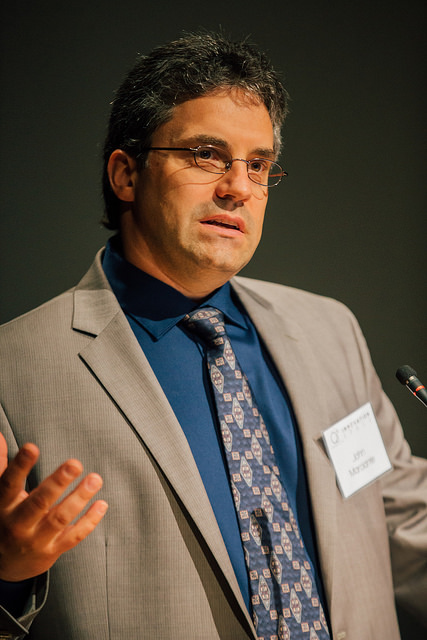
RAM Photonics was originally founded in 2009 as a vehicle to find “highly innovative university research that is so high-tech that it would be hard for anyone else to commercialize it,” said co-founder John Marciante. The company has worked with UC San Diego faculty on developing photonic systems, and the university is in a unique position because the Qualcomm Institute boasts an industry-class Photonic Systems Laboratory with infrastructure that in earlier times might have only been at Bell Labs or similar industry facilities. RAM Photonics currently licenses technologies for medical, high-power machining and communications applications. “It’s very challenging because you’re trying to take a lab demo done in a multimillion-dollar lab and turn it into a product that the UPS guy can throw onto his truck and it’s expected to arrive at the other end and work right out of the box with the press of a button,” said Marciante, who thinks that having an office on campus will enhance collaboration with UCSD researchers. “We haven’t found anything like this [the Innovation Space] at other universities yet, but now we are talking with them about it!”
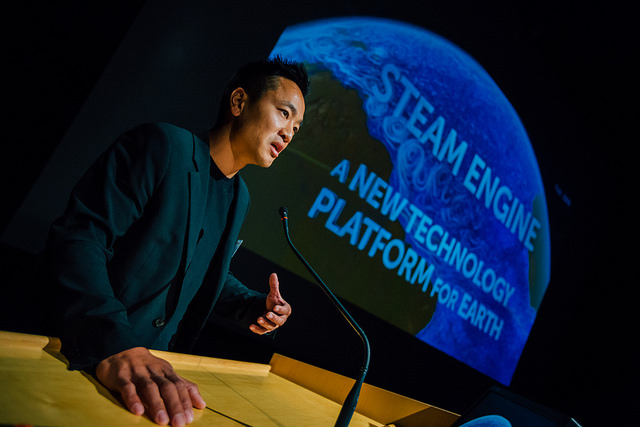
Qualcomm Insitute research scientist Albert Yu-Min Lin’s first startup was Tomnod, a company he sold to DigitalGlobe in 2013, which has continued to invest in the crowdsourcing pioneer. (Lin noted that more than eight million people worldwide went onto Tomnod’s website over one weekend during the search for the lost Malaysian airliner, scouring through satellite imagery of areas where it may have gone down.) But Lin opted to remain on the staff of the Qualcomm Institute after the buyout, in part because he was already looking to other startups. One of those is now taking shape under the not-yet-permanent name, STEAM Engine. Co-founding the company with a former president of the National Geographic Society and one of the leading game platform designers, Lin hopes to “change how classrooms engage in science.” Instead of focusing on what was published in a textbook a generation ago, STEAM Engine would tap “highly immersive storytelling, game play, and, what I’m most excited about, citizen science” to give students first-hand experiential knowledge of science. “When I look at a network of connected classrooms and distributed sensors, I see a massive-scale living laboratory where students can use the planet as our classroom,” observed Lin. “If you have kids with cell phones across the country, you can map the migratory patterns of indicator species. It’s the most exciting part of science – the edge of the unknown.” The scientific community will play a critical role in validating the topics and ensuring that the classroom has the latest science, even before it appears in textbooks. But producing the “engine” will not come cheap, and the company is hoping to announce its first big infusion of capital soon. As evidenced in the Hollywood-style ‘concept video’ Lin showed, it’s clear that the company is ambitious. “Science should be able to compete with the other visual distractions that kids experience through our hyper connectivity,” said Lin. “We are living in a connected universe, and we have to bring it into the classroom at an earlier age.”
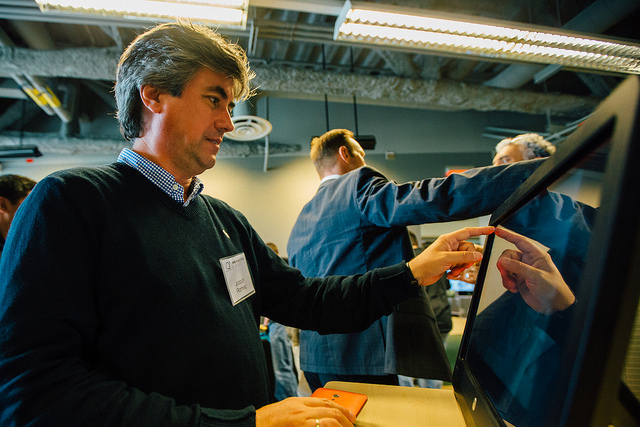
Joaquin Ramirez, CEO of Technosylva, splits his time between Spain and San Diego, “creating tools in the age of megafires” and global climate change. He says that for better or worse, when most of the world looks for expertise in dealing with wildfires, it looks to Southern California. But when he began to look more closely at the development of geospatial support wildfire systems, he recognized that his Spanish customers had similar concerns to those in California, and that collaboration between the two locations could benefit everyone (including the 178,000 firefighters in the U.S., and the owners of structures lost to wildfire, including 38,000 homes). “They need modern tools to help firefighters,” Ramirez told the media. “This is the place to do that.” Ramirez collaborates with the NSF-funded WIFIRE project and with Qualcomm Institute geospatial expert Jessica Block, and he anticipates working with other groups in the building, including the visualization team that builds virtual-reality systems on which firefighters could be trained. Said Ramirez: “We are confident that being here will let us jump to disruptive technologies to make wildfire management and fighting fires safer at the level that is needed.”
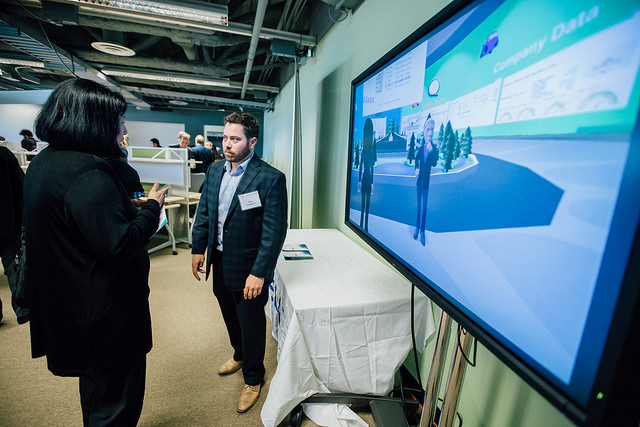
Earlier this year, VirBELA completed its transition from being an internal project run by staff of the Rady School of Management at UC San Diego, to a commercial spinout from Rady. “We transferred out of Rady in the spring, and now we’re back at UCSD,” said co-founder Alex Howland. Howland and colleagues raised nearly $2 million to build the crown jewels of VirBELA – a virtual-reality environment designed to be used for higher education and high-level corporate training and recruiting. “Kids spend a lot of time in virtual worlds for play, but this was a great opportunity to provide simulations that will entice behaviors that are consistent, or inconsistent, with competencies that they will need on the job,” he said. Recruiters, for example, could put a candidate into a simulation of a corporate crisis to observe their strengths and weaknesses (rather than finding out too late that a new hire was not equipped for the job). In the first version of VirBELA, distributed teams of MBA students from across the world were tasked with running an automobile company and other simulations – even with “players” speaking more than one language. The company is also expanding the variety of tools and metrics that companies can use to analyze the game-play of students in the simulations, e.g., to determine who is most proactive, and who may need extra coaching. Howland said that moving into the Innovation Space was a no-brainer for the company. After all, VirBELA has depended heavily on access to student game developers, MBA student users, and faculty guru Sheldon Brown, the designer of virtual worlds and director of the Arthur C. Clarke Center for Human Imagination, which is also located in Atkinson Hall.
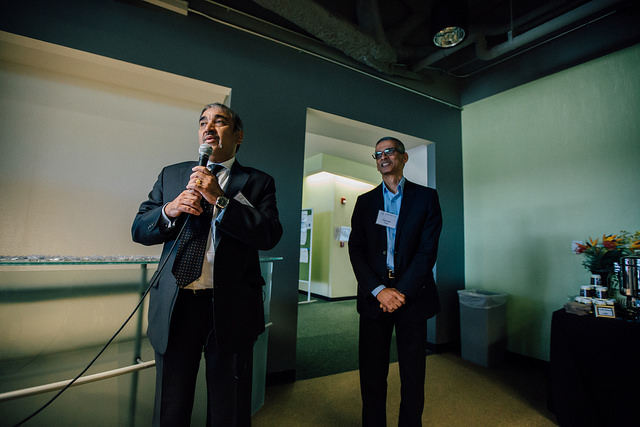
QI Director Ramesh Rao
During the networking reception in the second-floor Innovation Space, UC San Diego Chancellor Pradeep K. Khosla echoed Vice Chancellor Brown’s earlier remarks. “This could not be more timely,” said Khosla. “The Qualcomm Institute Innovation Space is not only an agent for economic transformation, but also an agent of economic development in San Diego, bringing together outside entrepreneurs and inside students and faculty in a single, entrepreneurial ecosystem” with other units on campus. He also noted that hours earlier, he had approved a plan put forward by the Vice Chancellor for Research to set aside a few hundred-thousand dollars to be allocated as seed money for campus startups like those in the Innovation Space that might be able to benefit from access to small-scale investments on the level of five, ten or fifteen thousand dollars per infusion. Khosla also noted that the UC Office of the President is exploring the creation of incubator-type spaces on other campuses, at the same time as it expands investing in a UC Venture Fund which could conceivably also become a source of capital for companies in the new Qualcomm Institute Innovation Space.
At least four more companies are now going through the process and have applications pending. One or more of them could join the cohort of companies in the Qualcomm Institute Innovation Space as early as this summer.
[Video of all the May 7 presentations is available on-demand through the Qualcomm Institute's YouTube channel. To watch the press briefing, click here. To watch Chancellor Khosla's remarks during the reception, click here. To view photography from the event or download high-resolution images, visit our Flickr photostream here.]
Related Links
Qualcomm Institute Innovation Space
Comhear
Foundation for Learning Equality
RAM Photonics
Sinopia Biosciences
STEAM Engine
Technosylva
VirBELA
Company presentations on YouTube
Video of Chancellor Khosla remarks
Event photos on Flickr
Media Contacts
Doug Ramsey, (858) 822-5825, dramsey@ucsd.edu
